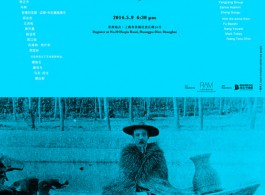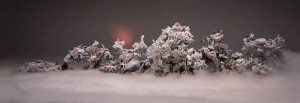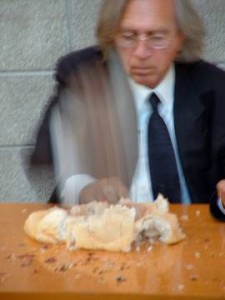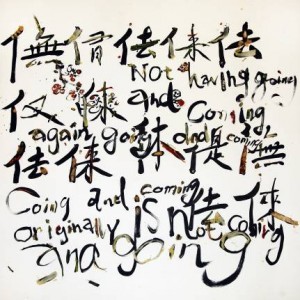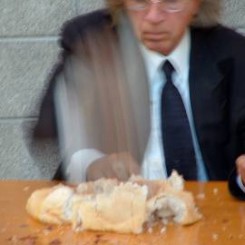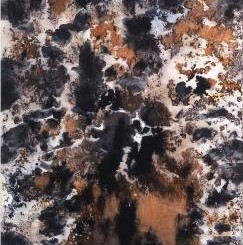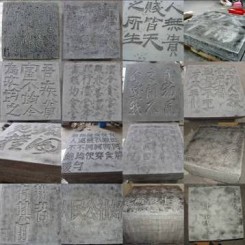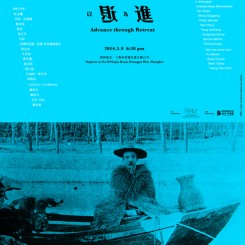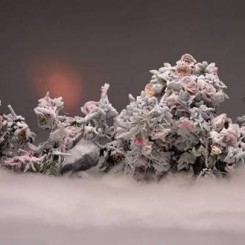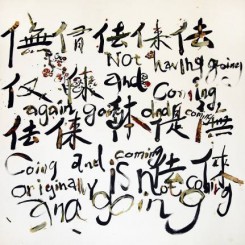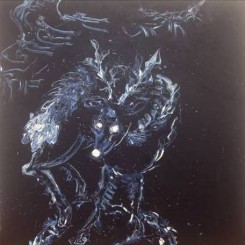[Press Release]
May 10th, 2014 – August 3rd, 2014
Rockbund Art Museum, No.20 Huqiu Road, Shanghai, China
Curated by Martina Köppel-Yang
Artists: Du Bianjiang, Jimmie Durham, Huang Yong Ping, Jiang Zhi, Li Zhengtian, Andreas
Mayer-Brennenstuhl, Qiu Zhijie, Wang Qingsong, Pablo Wendel, Xiao Kaiyu, Yang Jiechang,
Yangjiang Group, Zarina Hashmi, Zheng Guogu
With the works from Fu Baoshi, Kang Youwei, Mark Tobey, and Tsang Tsou Choi
About the Exhibition
The exhibition Advance through Retreat takes place amid the larger backdrop of recent developments in Chinese society and art in mind. For nearly two decades, traditional Chinese culture and traditional media has been a subject within the field of contemporary Chinese art. Numerous biennials and exhibitions on the topic—like, for example, the Shenzhen International Ink Painting Biennial, the project for the first Chinese Pavilion at the Venice Biennial in 2003, and most recently Yuan Dao—The Origin of Dao (Hong Kong Museum of Art, 2013), or again Ink Art: Past as Present in Contemporary China (Metropolitan Museum of Art. 2013)—indicate the existence of a tendency that is gaining ever greater importance, a tendency which shows the apparent need to rediscover and revaluate Chinese traditional media as a lingua franca. Certainly this interest in autochthonous Chinese culture is due to stimuli from various areas; political and economic motivations play as important a role as cultural and artistic ones, and Chinese players and lobbies are as active as their Western counterparts. But what is especially worth highlighting is the creation of a cultural identity of a new, self-confident, post-WTO-entry China. As a new and economically powerful global player, China seeks to affirm the “cultural position of a native culture with anexcellent tradition,” to cite Pi Daojian’s introduction to his exhibition Yuan Dao—The Origin of Dao. Yet up to the present day, most exhibitions on traditional Chinese media in a contemporary context have dealt with the subject through aspects of technique, media, aesthetics and values associated with traditional Chinese literati culture. The subject is tackled either to reaffirm a Chinese cultural identity or to revisit the East/West dichotomy, a spectre haunting Chinese cultural theory and critique since the mid-19th century.
This exhibition aims to look at traditional media from a different angle. It sets out to present artistic positions using traditional media and procedures, such as divination, the game, gambling and traditional strategies—for instance, “advance through retreat”—in order to develop autonomous languages that utter positions of resistance to the assimilating tendency and the power structures generated and maintained by the lingua franca. Advance through Retreat attempts to show, how, in specific historical moments, the use of or the retreat into tradition is employed as an efficient strategy of resistance.
Larys Frogier, the Director of the Rockbund Art Museum notes, “Advance through Retreat brings together Chinese and international artists who distance themselves from considering tradition as frozen time or as an established system. Rather, they question tradition as a way to test the limits and possibilities of contemporary creation, of remembering and remaking histories, and of revisiting certain established codes in order to re-invent today’s challenges of tradition in our urban societies, political contexts and daily lives. Advance through Retreat is thus a project in which tradition is embraced by contemporary artists as on-going living practices—from re-writing different layers of art and social histories to the uses and/or misuses of cultural codes, images and mundane objects. It is thus clear that tradition is not only about a simplistic opposition between past and present; it is about an evolving process of using, transforming, reinterpreting, and developing cultures. Hence in the exhibition Advance through Retreat, tradition is represented, performed and questioned as a whole set of practices, images, and objects based on vernacular, daily activities.” Indeed, intrinsically linked to the Chinese imperial system and its institutions as well as to power, calligraphy and traditional Chinese painting have been used as a unifying tool throughout Chinese history. In particular calligraphy and its specific styles served as lingua franca not only binding the vast territory with its diverse regional cultures and dialects together and guaranteeing cultural coherence, but also conferring social status and granting access to power for those who had the disposition to use and understand this medium. The written word, as poetry or calligraphy, is therefore also one important focus of the exhibition Advance through Retreat.
The retreat into tradition as a means of resistance and development of an autonomous language is not only a practice in the field of contemporary Chinese culture but also in that of contemporary and modern culture as such. The exhibition therefore includes works by artists of different origins and different times. Marc Tobey’s retreat into Arabic and Eastern thought and calligraphy that stimulated the development of his influential white writing in the early and mid-twentieth century, was as significant as Kang Youwei’s promotion of ancient metal-and stone inscriptions as models for a
reform of Chinese calligraphy and culture in the late nineteenth century, while Zheng Guogu and Yangjiang Group’s rediscovery of local traditions and vernacular is as fundamental a tendency in contemporary Chinese art. In her set of woodblock prints “Home is a Foreign Place” Zarima Hashmi attributes as much importance to the retreat into the autobiographic and a personal but yet universal vernacular as does Tsang Tsou Choi—or indeed Jiang Zhi in his “Love Letters” and Wang Qingsong in “Auspicious Snow”. Li Zhengtian, Qiu Zhijie, Xiao Kaiyu and Yang Jiechang’s works show as much the artists’ beliefs in the potential of art and tradition to challenge and transform our vision of reality as does Pablo Wendel’s video. Finally, Jimmie Durham’s act of smashing objects in his video ”Smashing” is as much an attempt to renegotiate modernity as is Huang Yongping’s “Big Roulette with Four Wheels” or Andreas Mayer-Brennenstuhl’s “Die Moderne redigieren / Editing Modernity”, or again Fu Baoshi’s album leaves after poems by Mao Zedong. Taking up all six floors of the Rockbund Art Museum, the exhibition Advance through Retreat runs from May 10th 2014 through to August 3rd 2014. About the Curator Martina Köppel-Yang is an independent art historian, art critic and curator. Born in 1964 in Germany, she now lives in Paris, France and Heidelberg, Germany. She is the member of the editorial board of Yishu Journal for Contemporary Chinese Art, Vancouver; member of the editorial board of Red Flag Collection, compilation of contemporary Chinese artists, Map Book Publishers, Hong Kong; Board member of Asia Art Archive, Hong Kong. She holds the following qualifications: Ph.D. in East Asian Art History, specialty: Modern and contemporary Chinese art, Ruprecht- Karls University, Heidelberg, Germany, September 2000; Ph.D. Dissertation: “Semiotic Warfare. A Semiotic Analysis of Works of Art of the Chinese Avant-garde of the period from 1979 to 1989.”; M.A. in East Asian Art History, Ruprecht- Karls University, Heidelberg, Germany, 1993 M.A. thesis: “The Bronzes of the State of Qin.”
About Rockbund Art Museum
The Rockbund Art Museum is a contemporary art museum which plays one of the finest roles in the creative art scene worldwide. Since its opening in 2010, Rockbund Art Museum has received high renown for its exhibitions of acclaimed Chinese and international artists. The Rockbund Art Museum is the first contemporary art museum in China that is fully devoted to supporting contemporary art production and creativity. The deep involvement of the Rockbund Art Museum aims to elevate contemporary art and energize the Chinese and international art scenes. This involves exhibiting artworks which represent the most relevant and exciting challenges for contemporary arts, such as: Cai Guo Qiang, Peasant Da Vincis (2010), Paola Pivi, Share, but it’s not fair (2012); contributing to the production of unseen and on-site artworks, such as Michael Lin’s Model Home (2012); and inviting curators to revisit the practice of exhibitions, such as Hou Hanru’s curation of By Day by Night; collaborating with acclaimed international institutions to explore the forefront issues in contemporary art, such as the exhibition From Gesture to Language (2013) co-curated with Pascal Torres Guardiola, Curator of Chalcography at the Louvre and of the Edmond de Rothschild Collection; and inventing the strong platform to support the artistic explorations of emerging artists from across Asia, the on-going project of award, exhibition, research and education of HUGU BOSS ASIA ART (from 2013). The Rockbund Art Museum is where artists and curators can develop art projects that require specific and often strong needs. It embraces various creative practices to bridge various disciplines such as design, architecture, dance, and promote powerful established artists as well as emerging art projects.
The Rockbund Art Museum strives to spread humanistic values and to promote art by offering all audiences the best conditions in encountering artworks, and by being dedicated to the research, exchange and promotion of contemporary art. The recently launched research and education platforms open the museum up for collaboration with universities, foundations and colleges, and for the co-organization of a wide range of activities in the form of lectures, seminars, screenings, performances, workshops and educational programs. The Rockbund Art Museum envisions itself as an open and vibrant museum that strives to provide support to contemporary artists and curators, to confront daring challenges for a creative contemporary art scene, and to generate lively programs of exhibitions and cultural events. In this way it becomes one important part of the cultural production and education mechanism of contemporary society. For more information on RAM, please visit www.rockbundartmuseum.org.
About ROCKBUND
As an integral element of the historic Bund waterfront, Rockbund is situated at the birthplace of modern Shanghai with her dazzling array of architectural styles. In order to protect this valuable aspect of the urban fabric and cultural heritage, the Rockbund preservation and development project has the stated aim of “restoring the original style and remodeling its function.” The project stretches from Yuanmingyuan Road and Park 33 in the east, Suzhouhe Road in the north, Huqiu Road in the west and Beijing Road in the east, and sits at the confluence of the Huangpu and Suzhou rivers. Aside from restoring eleven protected historical buildings, Rockbund will also build six new buildings with the goal of creating a high-end luxury district with a captivating environment for luxury retail, fine-dining, serviced apartments and commercial offices, recreating the glamour of Shanghai for a new age. With the opening of the Rockbund Art Museum, the first of the eleven historic buildings, Rockbund is re-establishing the origin of the Bund as a hub for arts and culture. For more information on Rockbund, please visit www.rockbund.com.

